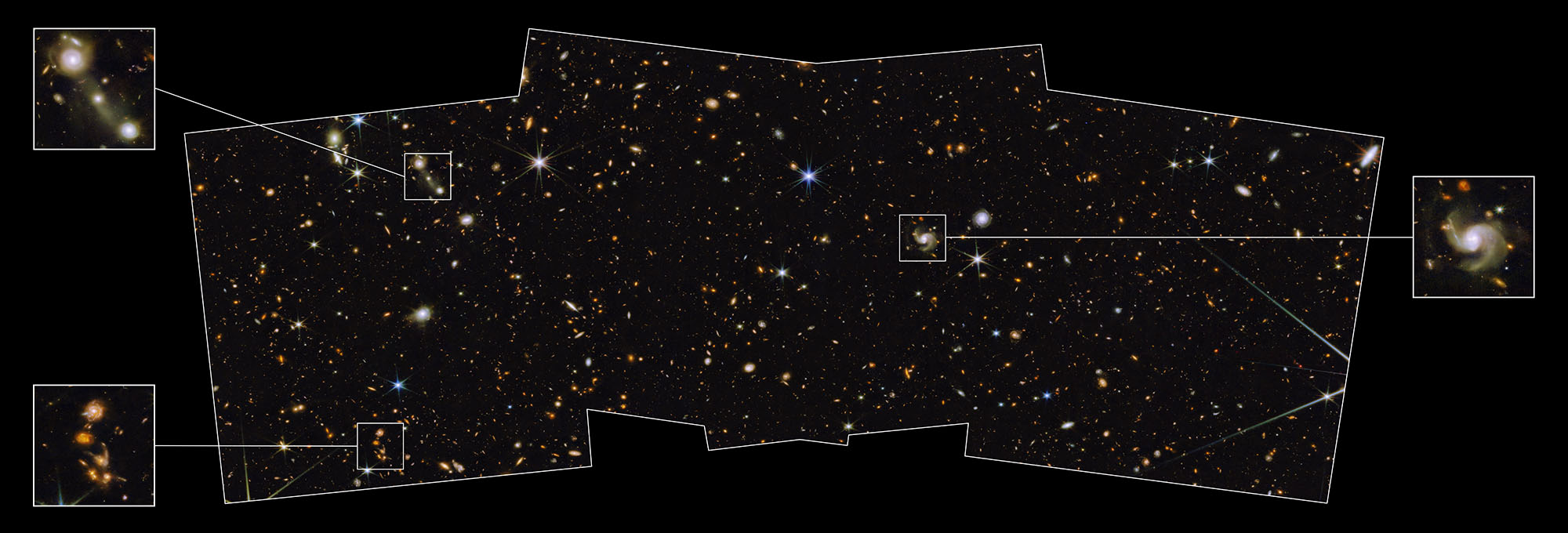A new deep field from the James Webb Space Telescope shows how galaxies evolved in the early universe.

NASA / ESA / CSA / A. Pagan (STScI) & R. Jansen (ASU); Science: R. Jansen, J. Summers, R. O'Brien, R. Windhorst (ASU) / A. Robotham (ICRAR / UWA) / A. Koekemoer (STScI) / C. Willmer (UofA) / the PEARLS team
In a "blank" region of sky reminiscent of the iconic Hubble Deep Field, this deep view from the James Webb Space Telescope reveals thousands of galaxies. Some of these existed a mere 300 million years or so after the Big Bang.
An international team of astronomers is using the Webb telescope to collect a series of wide-field views like this one of the distant universe, in a project dubbed Prime Extragalactic Areas for Reionization and Lensing Science, or PEARLS. In addition to "blank" fields such as this one, others will concentrate on distant quasars, early forms of galaxy clusters, as well as relatively nearby galaxy clusters that gravitationally lens and magnify the universe behind them. (The status of these observations can be seen on the JWST scheduling website.)
The "blank field" shown above is one of the first to be released by the PEARLS team. To take it, Webb pointed in the direction of Draco, the Dragon, the constellation that sits around the North Ecliptic Pole. Pointing in this direction presents several advantages: First, it's out of the dust-filled plane of the solar system and thus results in a clearer view of the distant universe. (It helps that there are no foreground stars in the way.) Even in exposures lasting only some 30 seconds apiece, Webb finds galaxies and stars as faint as 29th magnitude — some 600 times fainter than the natural glow of the darkest skies on Earth.
Just as importantly, this field is always visible to Webb at its location at the L2 Earth-Sun Lagrange point, which means the telescope can return to image this field again and again. “This unique field is designed to be observable with Webb 365 days per year, so its time-domain legacy, area covered, and depth reached can only get better with time,” explains Rogier Windhorst (Arizona State University). Windhorst led the publication of these first results in the Astronomical Journal.
PEARLS of Wisdom
The North Ecliptic Pole image above shows galaxies assembling over time: tidal tails swirl around colliding galaxies, individual globular clusters surround elliptical galaxies, and knots of star formation can be seen in spirals, team members report.
As part of their study of galaxy assembly, the astronomers counted the galaxies in the field to determine how many galaxies shine at any given magnitude. What they find matches well with previous work — for example, there are more fainter galaxies than brighter ones — but their counts include galaxies six times fainter than telescopes have seen before.
They also find that as they look farther in space and further back in time, galaxies gradually rewind from blue, spiral-shaped galaxies in the modern-day universe to redder, dustier galaxies in the distant past. (At least some of these are red spirals.)
With the fields imaged so far, the team also estimates the amount of diffuse light — that is, light that's not coming from galaxies or stars but from the universe at large.
“The diffuse light that I measured in front of and behind stars and galaxies has cosmological significance, encoding the history of the universe,” says graduate student Rosalia O'Brien (Arizona State University).
"A possible source of diffuse light are tidal tails of long-lived stars pulled out in galaxy interactions," the team writes. But the astronomers also emphasize that the study of diffuse light will require a lot more Webb observations, and a better understanding of the calibration of those observations, before they can reach firm conclusions about where this light is coming from.
Read more about PEARLS in the James Webb Space Telescope's press release.
 3
3









Comments
B l a k s t a r
December 24, 2022 at 7:32 pm
Thanks for the link to the paper. It lists target coordinates so I can find them in my app and know where to look to ponder these new finds and wonders.
You must be logged in to post a comment.
tony1tf
December 28, 2022 at 4:12 am
As Webb produces diffraction spikes, how do these get subtracted to find the excess diffuse light?
You must be logged in to post a comment.
Monica YoungPost Author
December 29, 2022 at 11:17 am
Astronomers model the shape of these diffraction spikes, fitting it to what's visible in the image, and then subtract them. Then they also construct a model for the stellar and galactic light in the image, and subtract that too. It's a complex process!
You must be logged in to post a comment.
You must be logged in to post a comment.